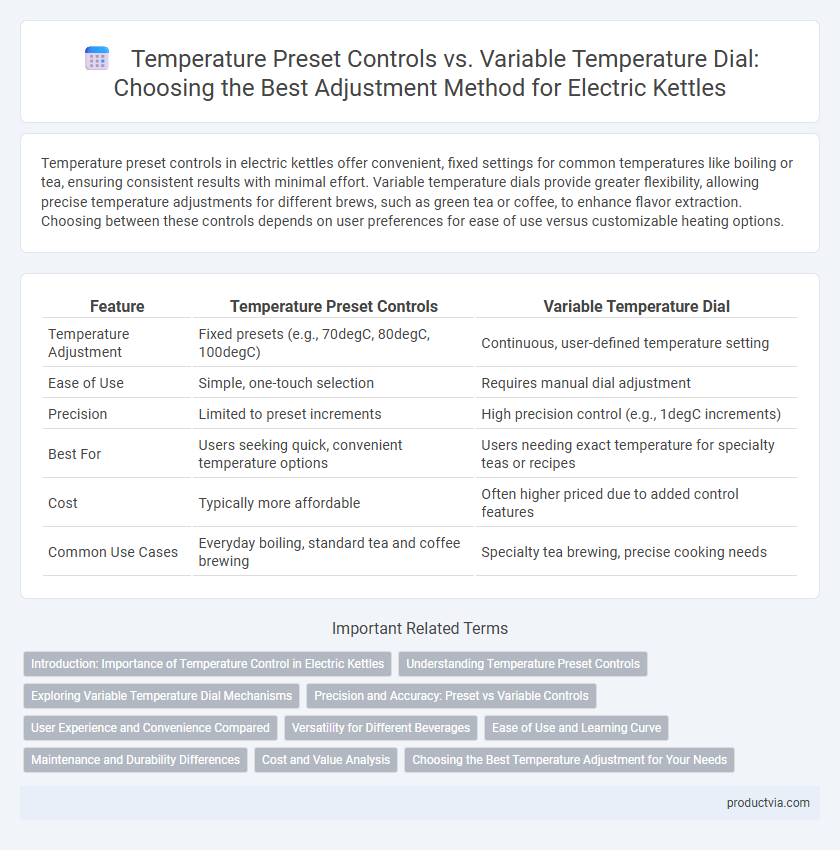Temperature preset controls in electric kettles offer convenient, fixed settings for common temperatures like boiling or tea, ensuring consistent results with minimal effort. Variable temperature dials provide greater flexibility, allowing precise temperature adjustments for different brews, such as green tea or coffee, to enhance flavor extraction. Choosing between these controls depends on user preferences for ease of use versus customizable heating options.
Table of Comparison
| Feature | Temperature Preset Controls | Variable Temperature Dial |
|---|---|---|
| Temperature Adjustment | Fixed presets (e.g., 70degC, 80degC, 100degC) | Continuous, user-defined temperature setting |
| Ease of Use | Simple, one-touch selection | Requires manual dial adjustment |
| Precision | Limited to preset increments | High precision control (e.g., 1degC increments) |
| Best For | Users seeking quick, convenient temperature options | Users needing exact temperature for specialty teas or recipes |
| Cost | Typically more affordable | Often higher priced due to added control features |
| Common Use Cases | Everyday boiling, standard tea and coffee brewing | Specialty tea brewing, precise cooking needs |
Introduction: Importance of Temperature Control in Electric Kettles
Precise temperature control in electric kettles enhances brewing quality by allowing users to select optimal heat settings for different beverages such as green tea, coffee, or herbal infusions. Temperature preset controls offer convenience with fixed, accurate settings tailored to common needs, while variable temperature dials provide customizable adjustment for fine-tuning the water temperature. This versatility impacts flavor extraction and prevents overheating, ensuring an optimal drinking experience.
Understanding Temperature Preset Controls
Temperature preset controls in electric kettles ensure precise water heating by offering fixed temperature options tailored for specific beverages like green tea at 175degF or coffee at 200degF. These presets optimize brewing by maintaining consistent temperatures, preventing overheating and preserving flavor profiles. Compared to variable temperature dials, preset controls provide ease of use and accuracy, ideal for users seeking specific temperature settings without manual adjustment.
Exploring Variable Temperature Dial Mechanisms
Variable temperature dial mechanisms in electric kettles provide precise control by allowing users to select exact temperatures, enhancing versatility for different beverage needs such as green tea or coffee. These dials typically employ a potentiometer or digital sensor integrated with a microcontroller to regulate heating elements accurately. Compared to temperature preset controls, variable dials offer customizable temperature settings, improving user experience through tailored heat adjustment and energy efficiency.
Precision and Accuracy: Preset vs Variable Controls
Temperature preset controls provide consistent accuracy by offering fixed, factory-calibrated settings ideal for common beverage temperatures, ensuring precise repeatability. Variable temperature dials allow fine-tuned adjustments, enabling users to select exact temperatures for specialty teas or recipes but may sacrifice some accuracy due to manual calibration. Overall, preset controls prioritize precision with standardized settings, whereas variable dials emphasize customization at the potential cost of exact temperature accuracy.
User Experience and Convenience Compared
Temperature preset controls in electric kettles offer quick, one-touch convenience by allowing users to select common temperature settings ideal for specific beverages like tea or coffee, enhancing ease of use and reducing guesswork. Variable temperature dials provide more granular control, catering to precise temperature preferences but may require more time and attention to adjust, potentially complicating the user experience for those seeking simplicity. For optimal convenience, preset controls are favored by users prioritizing speed and consistency, while variable dials appeal to those who value customization and precision in water temperature.
Versatility for Different Beverages
Temperature preset controls in electric kettles offer precise settings ideal for common beverages like green tea at 175degF or coffee at 200degF, ensuring optimal flavor extraction. Variable temperature dials provide versatile, continuous adjustment across a wide range, catering to specialty teas and custom brewing preferences. This flexibility in temperature control enhances the kettle's adaptability for diverse beverage types and personal taste profiles.
Ease of Use and Learning Curve
Temperature preset controls simplify operation by offering one-touch settings for common temperatures, making them ideal for users seeking convenience and minimal learning. Variable temperature dials provide precise control over water temperature, appealing to tea enthusiasts and those who prefer customization but may require a steeper learning curve. Overall, preset controls enhance ease of use, while variable dials demand more user familiarity for accurate temperature adjustments.
Maintenance and Durability Differences
Electric kettles with temperature preset controls tend to have fewer wear-and-tear issues due to their simplified electronic components, resulting in lower maintenance requirements. In contrast, variable temperature dials involve mechanical parts that are more prone to breakdown and require periodic calibration or repair to ensure accurate temperature adjustments. Durable materials and quality build in both types largely determine longevity, but preset controls typically offer enhanced reliability due to reduced physical manipulation.
Cost and Value Analysis
Temperature preset controls in electric kettles offer precise, user-friendly settings that typically increase the appliance's cost due to integrated digital components and software. Variable temperature dials provide a more affordable, flexible alternative, allowing users to select temperatures within a continuous range, but may sacrifice exact accuracy and repeatability. Evaluating cost versus value depends on user priorities: preset controls deliver convenience and precision worth the premium price, while dials appeal to budget-conscious consumers seeking adjustable functionality without digital enhancements.
Choosing the Best Temperature Adjustment for Your Needs
Temperature preset controls in electric kettles offer precise, one-touch settings ideal for users who want consistent brewing temperatures for specific beverages like tea or coffee. Variable temperature dials provide flexibility by allowing fine-tuned adjustments across a range of temperatures, catering to users with diverse preferences or experimental brewing methods. Selecting between preset controls and variable dials depends on your need for convenience versus customizable temperature precision in your daily routine.
Temperature preset controls vs variable temperature dial for electric kettle adjustment Infographic

 productvia.com
productvia.com